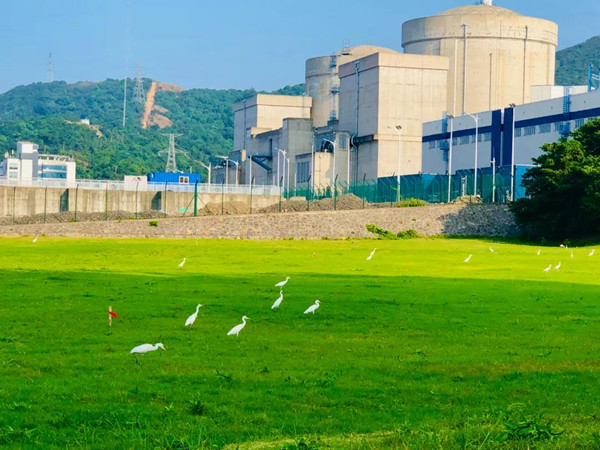Developing nuclear energy to achieve China's carbon neutrality goals
1. Accelerate the development of nuclear power to expand the scope of low-carbon energy

Nuclear energy is a low-carbon energy known for its high energy density, the stability of base load power, large unit capacity, highly intensive utilization of land resource, low cost of long-term operation and its ability to improve supply. It has played an increasingly important role in the transformation of a global energy mix and has become an irreplaceable component of clean energy in the future.
Only by increasing the utilization of nuclear power can the world achieve its targets concerning climate change, according to a prediction made by the International Atomic Energy Agency (IAEA). About 2,657 terawatt-hours (tWh) of electricity, or one third of low-carbon electricity in the world, came from nuclear power in 2019, signifying that nuclear energy has been playing an ever more important role in the global efforts to deal with climate change. The contributions made by nuclear energy to the production of low-carbon electricity have been even more obvious in the developed countries. Therefore, nuclear energy is irreplaceable low-carbon energy in the global action against climate change.
Right now, China has become a major country in terms of nuclear power. It is able to develop nuclear power at a fast speed and poised to become a leader in nuclear power. Given the gap between the installed capacity of nuclear power plants and the country's peak carbon dioxide emissions and carbon neutrality goals, it should accelerate the development of nuclear power. It is anticipated that the installed capacity of nuclear power units in operation will reach 180 million kilowatts in China by 2035, accounting for 5 percent of its total installed capacity of various powers and for 10 percent of the total amount of its electricity production.
2. Multiple purposes of nuclear energy facilitates the realization of China's peak carbon emissions and carbon neutrality goals

Energy supply is an important option to achieve China's peak carbon emissions and carbon neutrality goals. According to a report of the National Bureau of Statistics of China, an area of 21.1 billion square meters had been accessible to heating service, and urban central heating area had totaled 14.1 billion square meters as of the winter in 2019. Over 98 percent of heating service is supplied by coal. It is projected that coal-powered heating will annually release 1.35 billion tons of carbon dioxide. There is still no suitable alternative to replace coal to meet social needs for heating and it has become a major restraint for China to cut its carbon emissions. Therefore, China is in urgent need of finding a reliable and green solution to provide a large-scale heating service, with the aim of mitigating air pollution in the winter and reducing its carbon emissions.
The nuclear energy heating project at the China National Nuclear Corporation (CNNC)'s Qinshan Nuclear Power Plant in Haiyan, East China's Zhejiang province, has solved the problem. It is expected to annually cut 24,600 tons of standard coal consumption, reducing the emissions of 1,817 tons of sulfur dioxide, 908 tons of nitrogen oxide and 59,000 tons of carbon dioxide yearly when the project is in full operation.
The introduction of a pool-type low-temperature reactor, Yanlong DHR-400 (400 MWt District Heating Reactor), is a creative solution made by CNNC to replace coal with nuclear energy. A unit of Yanlong DHR-400 can provide over 300,000 people with heating service, equivalent to the reduction of 320,000 tons of coal consumption, 160 million cubic meters of natural gas consumption, 5,000 tons of dust, 50,000 tons of ash, 640,000 tons of carbon dioxide, 5,000 tons of sulfur dioxide and 1,600 tons of nitrogen oxide, effectively reducing pollution and carbon emissions at the same time.
Nuclear energy, a carbon-free source of energy supply, is shifting from serving the one purpose of power generation to multiple purposes. In addition to nuclear energy heating, it has played an important role in gas supply for industrial purpose, sea water desalination, and the making of hydrogen as well as isotopes. Besides, in space, deep water and islands, nuclear energy features such unique strengths as being clean, efficient, sustainable, and being a source of multi-form energy supply.
3. Accelerate the exploration of other sources of low-carbon green energy

Besides nuclear energy, CNNC has stressed the exploration and development of geothermal energy, another major green energy, over the past few years.
With the support of the China National Nuclear Power (CNNP) of CNNC, the Beijing Research Institute of Uranium Geology (BRIUG) has conducted investigation of geothermal energy in Southwest China's Tibet autonomous region in recent years. The BRIUG made a breakthrough in the exploration of high-temperature geothermal energy in the autonomous region in October 2020. The temperature of local geothermal energy in a 437-meter deep drill hole reached 185 degrees Celsius, which can be directly used for electricity generation.
Geothermal energy has been known for its high stability and being immune from the negative impacts brought by the change of weather conditions and season. However, the country has not yet given equal treatment to the electricity produced by geothermal energy as that by wind and photovoltaic power. The absence of policy support in terms of pricing has fundamentally hampered the willingness of relevant enterprises in the exploration and development of geothermal industry. Moreover, the collection of mineral resource tax has restricted the high-quality growth of geothermal industry as well. Therefore, it is advised to grant equal price to electricity produced by geothermal energy in Tibet.
4. Promote the popularization of nuclear science

The importance of nuclear energy has become more and more obvious amid China's efforts to have its carbon dioxide emissions peak before 2030 and achieve carbon neutrality before 2060. Nuclear energy has become a sure choice for China to tackle climate change, deliver on its pledge to promote green and low-carbon development, and attain its peak carbon neutrality targets. However, the development of nuclear energy has been restrained by multiple factors such as ineffective nuclear popularization, lack of legal support for nuclear energy development and the negative effects of nuclear-related news.
Therefore, it is of great importance to communicate with the public the country’s nuclear energy policy, promote the popularization of nuclear science, conduct promotional events with broad public participation, and incorporate relevant knowledge into academic courses from elementary schools to universities.


